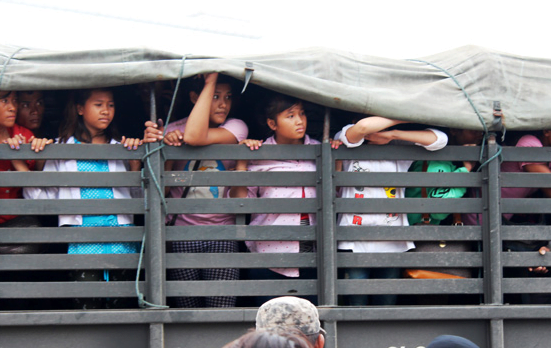One of the most troubling trends in global politics is that, despite a steady decline in armed conflicts over the past two decades, the number of people forcibly displaced by violence has surged to levels not seen since World War II.
While forced displacement is an increasingly massive feature of contemporary wars, it is typically treated as an inadvertent byproduct of conflict, rather than a deliberate strategy of it. Yet the flight of war-affected populations from their homes is frequently orchestrated, directed, and sustained by armed actors. New displacements in Iraq, for example, are partly a consequence of renewed sectarian cleansing by both Sunni and Shia militias, a tactic intended to both secure territory and contribute to “nation-building” through social engineering. Similar cleansing of Christian and Muslim communities has accompanied a recurrence of violence in the Central African Republic, where one in five civilians remains uprooted.
But strategic displacement extends well beyond these more extreme cases of ethnic and religious cleansing. Overshadowed by events in the Middle East, within the past few weeks the Pakistani military has haphazardly relocated nearly half a million civilians from the country’s Federally Administered Tribal Areas (FATA). Villages have been systematically depopulated to clear the region for counterinsurgency operations against anti-government militias. Pakistan has employed similar measures in previous battles with rebel groups, emptying communities in the Swat Valley between 2007 and 2009, and resettling tens of thousands of civilians in Balochistan province several years earlier. Yet those displaced from FATA have nowhere to go, as the government is failing to provide temporary housing or material assistance, forcing many to cope with “appalling” living conditions.
Population displacement has long been employed as a tool of statecraft and a weapon of war. Relocating communities enables authorities to assert control over contested areas, monitor restive populations, drain rebel-held territories of recruits and resources, and limit collateral damage. While those responsible commonly justify these strategies under the auspices of protecting civilians, they rarely provide the resources needed to address the humanitarian consequences. The Ugandan government’s resettlement of Acholi communities as part of its military campaign against the Lord’s Resistance Army confined nearly two million civilians to squalid and poorly protected camps. Strategic displacements in the Tamil areas of Sri Lanka have stripped thousands of civilians of their homes. Myanmar’s military leaders have repeatedly used displacement to marginalize ethnic insurgencies and repress minority groups, including the stateless Rohingya. And Colombian paramilitaries routinely expel civilians for political and economic gain.
In each instance, these state-induced relocations have caused immeasurable suffering and wreaked havoc on local communities. International relief efforts already struggle to keep pace with the needs of the uprooted (as evidenced in Syria and Iraq) and since most victims tend to be internally displaced, they lack the legal protections afforded to refugees and are at the mercy of their own governments, which sometimes block the distribution of aid. Because many displaced populations are not provided with shelter — only 10 percent of those uprooted in Pakistan are living in designated camps — the mere process of identifying those in need of assistance can be overwhelming.
The calculated use of forced displacement for strategic purposes further complicates the humanitarian response. Aid agencies confront a dilemma. By operating relocation camps and providing material supplies to the displaced, humanitarian actors shoulder what should be the government’s burden, creating perverse incentives for authorities to continue to use these tactics. To intervene can therefore amount to complicity in war crimes — an accusation that has beset organizations responsible for relieving displacement in northern Uganda. Yet if aid agencies do not intervene, they not only condemn vulnerable populations to misery; they risk exacerbating the security repercussions of forced migration, including conflict contagion, economic disruption, and social dislocation.
To address the challenges of responding to displacement, UN agencies and international actors must place a greater emphasis on prevention. Efforts to develop early warning systems for forced migration, and armed conflict more generally, are on the rise. But when combatants weaponize displacement, willfully facilitating the involuntary evacuation of civilians, the international community should undertake measures to discourage and punish them. Several multilateral treaties, including the 1948 Genocide Convention and the recently-adopted Kampala Convention, provide a legal basis for stopping strategic displacements and holding those culpable to account. If there are any types of forced migrations that we should be able to deter or prevent, it is those that are deliberately planned and executed by states and other armed actors.
Photo credit: International Organization for Migration. (Photo by Joe Lowry, 2014)
